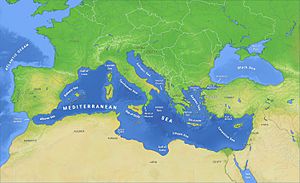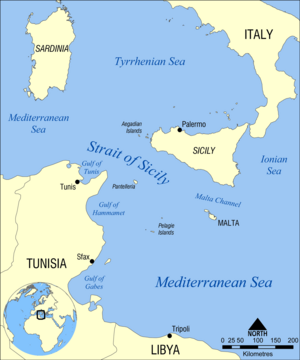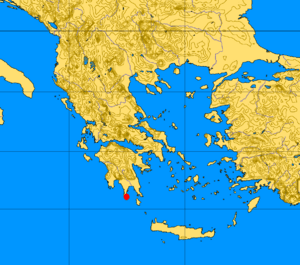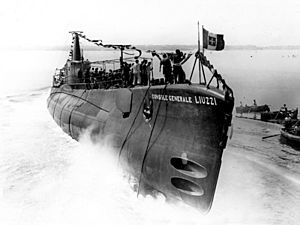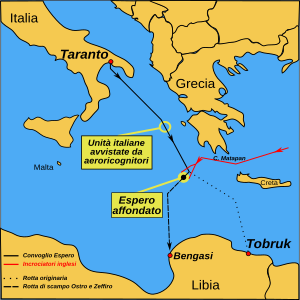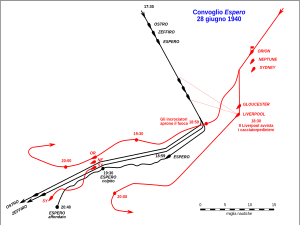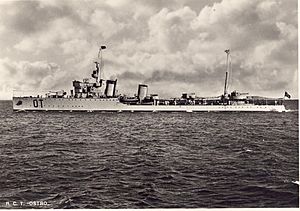Battle of the Espero Convoy facts for kids
Quick facts for kids Battle of the Espero Convoy |
|||||||
|---|---|---|---|---|---|---|---|
| Part of the Battle of the Mediterranean of the Second World War | |||||||
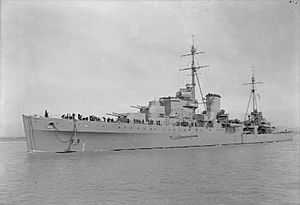 HMS Orion, circa 1942 |
|||||||
|
|||||||
| Belligerents | |||||||
| Commanders and leaders | |||||||
| Strength | |||||||
| 5 light cruisers | 3 destroyers | ||||||
| Casualties and losses | |||||||
| 1 light cruiser damaged | 175 killed 44 captured 1 destroyer sunk |
||||||
The Battle of the Espero Convoy happened on June 28, 1940. It was the first time Italian and Allied warships fought directly during World War II. Three fast Italian destroyers were sailing from Taranto to Tobruk in Libya. They were carrying special anti-tank units for defense against British attacks from Egypt.
At the same time, the British Mediterranean Fleet was also at sea. They were looking for enemy submarines near Crete. They also needed to protect three Allied convoys heading to Egypt. British planes from Malta spotted the Italian destroyers. The 7th Cruiser Squadron quickly moved to stop them. A running battle began south-west of Crete. The Italian destroyers were slowed down by their cargo and the rough sea.
During the battle, the Italian destroyer Espero was sunk. Its commander, Enrico Baroni, sacrificed his ship to help the other two destroyers, Zeffiro and Ostro, escape to Benghazi. Out of 225 people on board, 53 were rescued. The British and Australian ships used a lot of ammunition. This meant that convoys from Malta had to wait until more shells arrived.
Contents
Why the Battle Happened
Italy Joins the War
Italy needed to send supplies to its colony, Italian Libya. Supplies arrived at ports like Tripoli, Benghazi, and Tobruk. From there, goods were moved by trucks or small boats. In late 1939, Italy's military leaders thought the British and French navies were much stronger. So, they planned to focus on defending Italy and keeping enough supplies for a year.
However, Italy's leader, Benito Mussolini, wanted to join the war. He decided Italy would fight alongside Germany. He believed the war would be short, only about three months. On June 10, 1940, Italy declared war on Britain and France. Mussolini then ordered the Italian navy to protect supply routes to Libya.
The Italian navy, called the Regia Marina, had two modern battleships and 19 cruisers. But the British and French navies in the Mediterranean were much larger. They had three aircraft carriers, eleven battleships, and 23 cruisers. This meant the Allied navies were four times stronger. They could also bring in more ships if needed.
British ships were based in Gibraltar and Alexandria. French ships were in Toulon and Bizerte. Italy's main bases were Naples and Taranto. Smaller Italian forces were in Sicilian ports. Italian ships could meet up by sailing through the Strait of Messina. But this narrow passage was a dangerous place for an ambush.
After World War I, the Italian navy wanted its own air force. But in 1923, the Regia Aeronautica (Italian Royal Air Force) was created. This new air force took control of all naval aviation. They believed land-based planes could do everything the navy needed. This meant the navy didn't get its own aircraft carriers or special naval planes.
The air force didn't pay enough attention to the navy's needs. Experiments with torpedo planes were stopped. Even when the British showed how useful torpedo-bombers were, the Italian navy couldn't get its own. This lack of naval air support would be a problem in future battles.
Getting Ready for Battle
After Italy declared war, they expected Britain to attack eastern Libya. On June 11, Italian cruisers went on patrol near the Strait of Sicily. The next day, British cruisers were seen south of Crete. Italian ships were sent to patrol the route to Malta.
On June 12, a British submarine sank an Italian patrol boat near Tobruk. Later, an Italian submarine, Alpino Bagnolini, sank the British ship HMS Calypso south of Crete. Italy also worked to cut British communication cables around Malta.
Italian Supply Missions
It was hard to protect supply ships going to Tobruk. So, Italy decided to use warships and submarines instead. On June 19, the submarine Zoea carried ammunition to Tobruk. The next day, destroyers carried troops and anti-tank guns to Benghazi.
On June 25, a convoy with troops and supplies left Naples for Tripoli. The submarines Bragadin and Zoea also carried supplies. The Italian destroyers Espero, Zeffiro, and Ostro were chosen for a special mission. They were fast and could carry a lot of cargo. They were to transport anti-tank units to Tobruk.
British Convoy Plans
On June 27, British destroyers were to sail from Alexandria. They would search for submarines near Kythira and then go to Malta. Their main job was to protect convoys MF 1 and MS 2 heading to Alexandria. British Short Sunderland flying boats from Malta would help by scouting the area.
Convoy MF 1 was a fast convoy carrying civilians from Malta. Convoy MS 1 was slower, carrying naval supplies. The entire Mediterranean Fleet was ordered to protect these convoys. Another convoy, AS1, with seven ships, was sailing from Turkey to Egypt. It was escorted by two light cruisers, HMS Capetown and Caledon, and four destroyers.
The plan was for all three convoys to meet south of Cape Matapan on June 30. Five cruisers of the 7th Cruiser Squadron, including HMS Orion, Neptune, HMAS Sydney, Liverpool, and Gloucester, would be nearby. Two battleships, HMS Royal Sovereign and Ramillies, and the aircraft carrier HMS Eagle would also be ready to help.
June 27 Events
On the evening of June 27, British destroyers were north of Alexandria. They spotted an Italian submarine, Console Generale Liuzzi. The submarine quickly dived. The destroyers dropped depth charges, which are underwater bombs. After several attacks, oil appeared on the surface.
The submarine was badly damaged and forced to surface. The destroyers fired at it. When a white light was seen, it was taken as a sign of surrender. British sailors rescued survivors from the water. The submarine was then sunk. Italian sources say the crew sank their own submarine. Ten men died, including the commander.
The Battle Begins
On June 28, a British Sunderland plane from Malta spotted the Italian destroyers. This was around noon, west of Zakynthos, Greece. The plane didn't give their exact direction. The British thought the Italian ships were heading north. So, the 7th Cruiser Squadron turned north to intercept them.
However, another Sunderland plane spotted them later, still heading south. The British commander, Vice-Admiral John Tovey, ordered his ships to turn south-west and speed up. The British cruisers sailed in two groups. The first group included Orion, Neptune, and Sydney. The second group, about 5 miles away, had Liverpool and Gloucester.
The Italian destroyers were moving south-east at high speed. Liverpool spotted them at 6:30 p.m., about 100 miles north of Tobruk. The cruiser started firing three minutes later. The Italian ships were supposed to be faster than the cruisers. But because they were older, heavily loaded, and the sea was rough, the British ships slowly gained on them.
The Italians were surprised. They couldn't launch torpedoes because of the cargo on their decks. They tried to escape by making smoke. As darkness fell, it became harder for the British to hit them. At 7:05 p.m., Neptune reported torpedoes, and the British ships changed course.
The British ships focused their fire on Espero. By 7:20 p.m., they were closer. The Italian commander, Baroni, realized his overloaded ships were in trouble. He decided to sacrifice Espero to let the other two ships escape. He made smoke and moved his ship to avoid hits. Zeffiro and Ostro sped away to the south-west.
At 8:00 p.m., Espero was hit and stopped moving. As night fell and with little ammunition left, Tovey stopped the chase ten minutes later. He ordered Sydney to finish off Espero. Sydney got within 6,000 yards and was hit twice by shells from Espero. Sydney fired back, hitting Espero.
Espero began to burn from the front to the middle. At 8:35 p.m., Sydney got very close, about 2,000 yards behind the destroyer. Men jumped from the burning ship. There was a big explosion near the bridge. At 8:40 p.m., Espero sank.
Sydney launched its boats to rescue survivors. They used ladders and chairs to bring them aboard. The light from the burning ship and the fear of Italian submarines made them stop the rescue at 10:19 p.m. They had rescued 47 survivors. Sydney left a small boat with supplies for any remaining survivors. Three survivors died before reaching Alexandria. Six others were found alive on a raft by an Italian submarine 14 days later.
After the Battle
The battle lasted about two hours and ten minutes. The British ships fired around 5,000 shells. One Italian shell hit Liverpool but caused little damage. Some Italian prisoners told the British that Espero had 225 men and passengers. They also said that Baroni had died in the explosion. Other Italian survivors later said Baroni was only slightly hurt but chose to go down with his ship.
The British cruisers used up a lot of ammunition. This was a problem because Alexandria had only 800 6-inch shells left. The Battle of the Espero Convoy showed that long-range daylight naval battles used a lot of ammunition and didn't always have clear winners.
Because of the low ammunition, the Malta convoys were delayed. The British ships returned to Alexandria. Convoy AS 1 from Turkey was attacked by Italian planes but reached Egypt safely. If Italian planes had spotted the British cruisers earlier, all three Italian destroyers might have escaped. Baroni was given a special medal for his bravery after he died. The lack of ammunition and the danger of Italian submarines led to more convoy delays. This eventually led to another big battle, the Battle of Punta Stilo, on July 9, 1940.
What Happened Next
On June 29, British destroyers found the Italian submarine Uebi Scebeli on the surface. The submarine dived, but depth charges forced it back up. Survivors were rescued, and the submarine was sunk. The destroyers returned to Alexandria. Prisoners revealed that Italian submarines were patrolling between Crete and Africa.
The destroyers Zeffiro and Ostro reached Benghazi on June 29 and then Tobruk. The smaller Italian ships, Pilo and Missori, also reached Libya.
On July 5, British torpedo-bombers attacked ships in Tobruk harbor. They sank the destroyer Zeffiro and two merchant ships. Another destroyer and a liner were damaged. The next evening, British planes bombed an airfield in Sicily. On July 6, British cruisers and destroyers bombarded the port of Bardia. They hit two ships. The guns from the sunken Zeffiro were later salvaged and used to defend Bardia.
Ships Involved
Allied Forces
- Vice-Admiral John Tovey – Commander of the 7th Cruiser Squadron
1st Cruiser Division:
- Light cruisers: Orion (Flagship), Neptune, Sydney
2nd Cruiser Division:
- Light cruisers: Liverpool, Gloucester
Italian Forces
- Capitano di Fregata Enrico Baroni – Commander of the 2nd Destroyer Squadron
2nd Destroyer Squadron:
- Destroyers: Espero (Flagship), Ostro, Zeffiro
|


